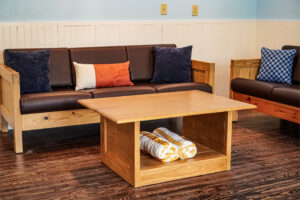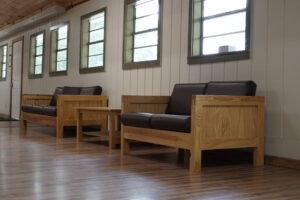Level II residential treatment provides a 24-hour therapeutic setting for adolescents who need more structure than outpatient care but do not require hospital-level acuity. The unit runs on a predictable daily schedule with clinical contact baked into mornings, afternoons, and evenings. Nursing oversight supports medication safety and basic health needs while therapists deliver evidence-based care in individual, group, and family formats. The point is not confinement. The point is a stable environment where symptoms are monitored closely, skills are practiced daily, and progress can be measured week to week.
Which Teens Benefit Most From Level II Care?
Families typically consider Level II when school avoidance persists, when depression or anxiety keeps resetting progress, when OCD rituals consume hours, or when trauma symptoms derail sleep and behavior. Emerging safety concerns such as self-harm thoughts that do not meet inpatient criteria also warrant a higher level of supervision while treatment intensifies. If a teen cannot sustain gains between weekly appointments, or if home becomes the only place therapy falls apart, Level II adds enough structure to change the trajectory.

How Does Daily Structure Improve Safety And Learning?
Brains learn under conditions that repeat. Waking at the same time, attending a consistent school block, participating in therapy at set hours, and winding down predictably at night teach the nervous system to stand down. As sleep stabilizes and meals become regular, attention and memory return. That cognitive lift makes therapy more efficient because teens can focus on the task at hand instead of scanning for the next surprise. Structure is not cosmetic. It is the delivery system that turns treatment plans into habits.
Which Evidence Based Therapies Should A Level II Program Use?
Effective programs rely on modalities with strong adolescent data. Cognitive behavioral therapy targets distorted thinking and avoidance patterns that feed depression and anxiety. Exposure and response prevention treats OCD by reducing rituals through planned exposures with coaching and accountability. DBT-informed work builds emotion regulation, distress tolerance, and interpersonal effectiveness so crises become manageable. Acceptance and commitment therapy helps teens clarify values and take small, consistent steps that rebuild a sense of agency. Family-systems work aligns the home environment with treatment goals so gains survive discharge.
How Does School Continue During Residential Treatment?
School is not an afterthought in effective adolescent programs. Credentialed education staff coordinate with the home district to protect credits and keep assignments realistic while symptoms settle. The academic block reinforces daytime routine and restores a sense of competence that therapy alone cannot replace. When school participation improves inside Level II, the return to campus after discharge feels like a continuation rather than a cliff.

How Do Families Participate Without Repeating Old Fights?
Parents are part of the treatment team. Family sessions focus on practical communication, clear limits, and de-escalation skills that can be used on school mornings and late evenings. The goal is not a perfect script. The goal is a short list of moves everyone can execute under stress so arguments shorten and recovery windows lengthen. When families practice these moves with coaching and then test them during passes, home begins to match the structure that made treatment work.
How Is Progress Measured And Discharge Decided?
Measurement makes care safer and fairer. Programs should track standardized symptom scales for mood and anxiety, safety indicators, sleep trends, school engagement, and participation in exposures or skills practice. Teams then adjust plans based on data rather than impressions. Discharge timing depends on sustained gains, not a calendar date. Clear step-down plans bridge to intensive outpatient or outpatient therapy, with medication management and school coordination scheduled before the teen leaves the unit.

What Should You Ask Before Choosing A Level II Program?
Ask how therapy will be individualized for your teen’s diagnosis, how the team handles technology and privileges, how school credits are protected, and how safety is monitored between sessions. Ask which measures guide progress and what criteria signal readiness to step down. Programs that answer precisely are prepared to treat precisely.
What Does Level II Mean And Where Did The Label Come From?
“Level II” is not a single national standard. Different frameworks use numbers in different ways, so the label must be read in context. For child and adolescent mental health, many state licensure systems and Medicaid manuals use Level II to describe a moderate‑intensity residential setting with 24‑hour supervision, daily therapy, and onsite support. In practice, that means Level II typically sits above basic or group‑home care and below secure, high‑intensity, or hospital‑based programs.
Several jurisdictions define Level II this way. State rules and payer manuals often describe Level II residential programs as structured, rehabilitation‑oriented settings that house youth who need extensive support for daily living, consistent supervision, and coordinated clinical services. You will also see Level II used for therapeutic group homes that serve as a step‑down from inpatient care or as an alternative to higher‑security residential care.
For families, the takeaway is practical. Ask the program to name the framework behind its Level II label and to specify concrete elements such as staffing ratios, nursing coverage, school integration, therapy frequency, average length of stay, and safety procedures. Level II signals a predictable, moderate‑intensity residential setting that is designed to stabilize symptoms, rebuild routine, and prepare a measured step down to intensive outpatient or outpatient care.
Ready To Start With BlueRock Behavioral Health?
If this level of structure matches what your family needs, take the next step now. Call us to speak with an admissions specialist, review clinical fit, verify insurance, and map a start date that aligns with school and family schedules.






















